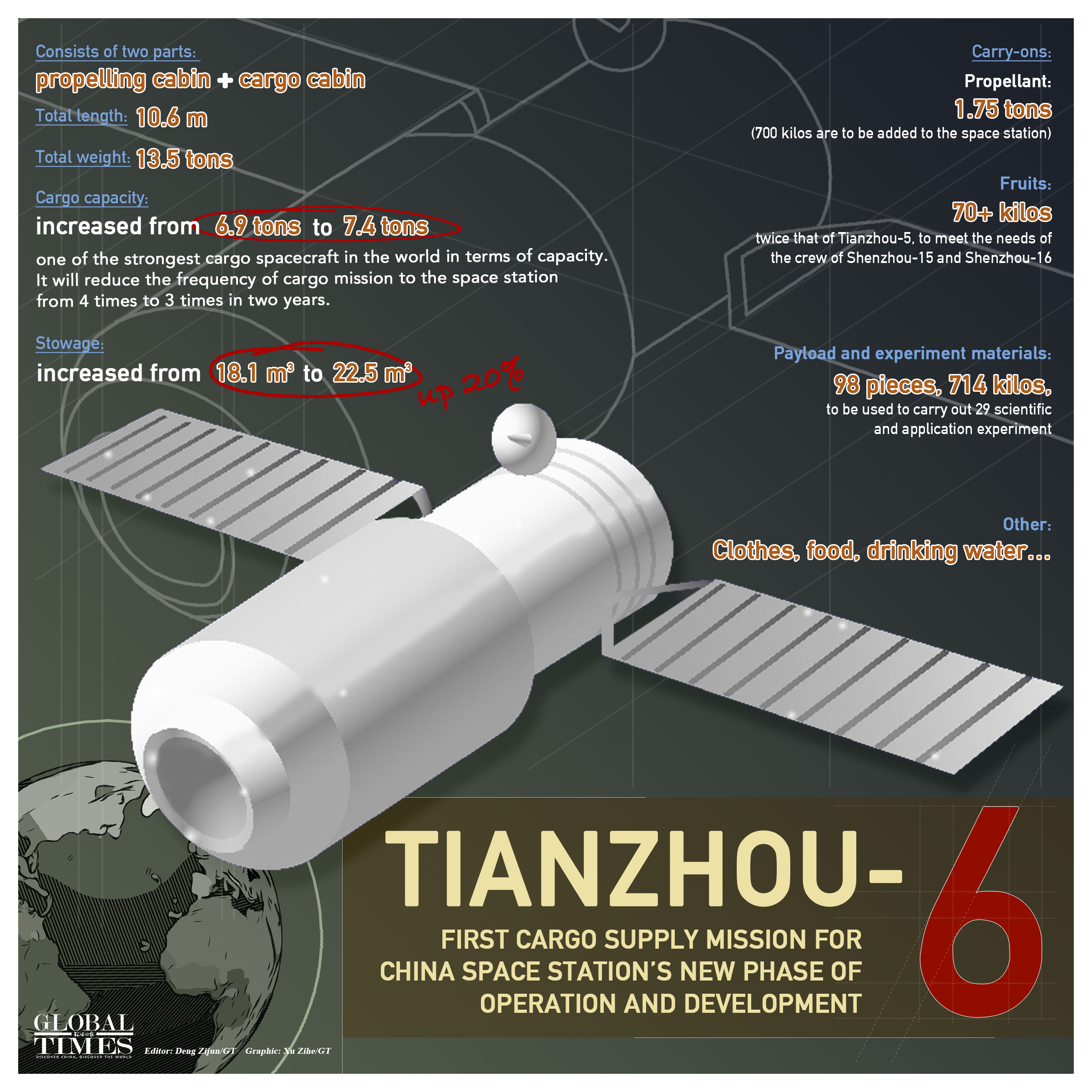China successfully launches flagship cargo mission supporting China Space Station's new operation phase
China successfully launched the Tianzhou-6 cargo spacecraft into designated orbit on Wednesday, achieving a key victory of the first launch mission to the China Space Station since the Chinese crewed space outpost entered a normal operation and development phase at the end of 2022.
Carrying the Tianzhou-6 cargo spacecraft, China's Long March-7 Y7 carrier rocket took off from the Wenchang Space Launch Site in South China's Hainan Province on Wednesday at around 9:22 pm. After a flight lasting 10 minutes, the flagship spacecraft for the China Space Station new phase entered its preset orbit, which, according to the China Manned Space Agency (CMSA), marked the success of the launch mission.
The launcher's developer, the China Academy of Launch Vehicle Technology (CALT), under the state-owned space giant China Aerospace Science and Technology Corporation (CASC), told the Global Times that Long March-7 has executed five Tianzhou cargo spacecraft launches since its maiden flight in 2016, with a perfect success rate.
The CALT also disclosed that following the Wednesday mission, another two orbital launches for the China Space Station would be carried out in 2023.
Wang Ran, chief designer of the cargo spacecraft system with China Academy of Spacecraft Technology (CAST) under the CASC, revealed that the new series of the Tianzhou cargo spacecraft, starting from Tianzhou-6 to Tianzhou-11, would be further upgraded compared to its predecessors, as its cargo capacity has been increased from the previous 6.9 tons to 7.4 tons, which makes the new Tianzhou spacecraft one of the strongest cargo spacecraft in the world.
It was the first time that Tianzhou spacecraft possesses the cargo capacity exceeding 7 tons, which would reduce the frequency of cargo mission to the space station to three times in two years from four times in two years, boosting the comprehensive efficiency of the space station project.
According to the CAST, the Tianzhou-6 cargo spacecraft is tasked with ferrying essential supplies for taikonauts that can sustain a three-strong crew's 280 days in space, around 260 different goods weighing some 5.8 tons as well as multiple payloads for scientific experiment and technology verification, to the China Space Station.
Lü Congmin, deputy chief designer of the space application system and research fellow with the Technology and Engineering Center for Space Utilization under the Chinese Academy of Sciences, told the Global Times that Tianzhou-6 will upload 98 pieces of payload and experiment materials weighing some 714 kilograms to the China Space Station.
They will be used to carry out 29 scientific and application experiments in four domains - space life science and biotechnology, microgravity fluid physics and combustion science, space material science, and space application of new technology - according to Lü.
According to developers with the CAST, starting with the Tianzhou-6, the technology team has upgraded the spacecraft system, including making improvement to the cargo cabin of the spacecraft and boosting the airtight cabin's cargo transport capability, which would provide more goods to the taikonauts to sustain a longer stay in space.
The CAST stressed that through the implementation of comprehensive guarantee measures, 100 percent localization of key components has been realized.

Graphic: GT
The Tianzhou-6 cargo spacecraft is also the most versatile of its kind in terms of supporting capability in orbit; it is tasked to not only deliver supplies to the China Space Station, complete the attitude control of the space station combination, but also carry out space scientific and technological experiment. It will also unload waste from the China Space Station before falling back with control, the CAST told the Global Times in a statement.
The stowage of the airtight cabin of the Tianzhou-6, according to the CAST insiders, has increased from 18.1 cubic meters to 22.5 cubic meters, an increase of 20 percent. The cargo capacity of the airtight cabin increased by 22 percent to 6.7 tons after upgrade, and that for the whole craft has been increased from 6.9 tons to 7.4 tons.
The Tianzhou-6 spacecraft will also deliver some 70 kilograms of fresh fruit for the crew to enjoy, which is twice the weight of fruit carried by the Tianzhou-5, according to Wang.
"We used to be unsure about how long will such fresh fruit can be preserved in space. However, after learning from the past year, we are now sure about that we have the capability to upload more fruit at a time," Wang noted.
Tianzhou-6 also delivered 1.75 tons of propellant, of which 700 kilograms will be provided to the space station.
Photos
Related Stories
- China's cargo craft Tianzhou-6 ready for launch in Hainan
- Shenzhou XV mission crew members set China record
- Selection of foreign space crew to start
- China to launch 2 manned spaceships plus cargo spacecraft annually from 2023
- China's Shenzhou-14 separates from space station combination
- China's Shenzhou-14 astronauts to return to Earth on Dec. 4
- Crew ready for launch of Shenzhou XV mission
- China lays out plan for future deep space exploration
- China's space-based observatory sends first solar image
- China launches lab module Mengtian as space station approaches completion
Copyright © 2023 People's Daily Online. All Rights Reserved.









